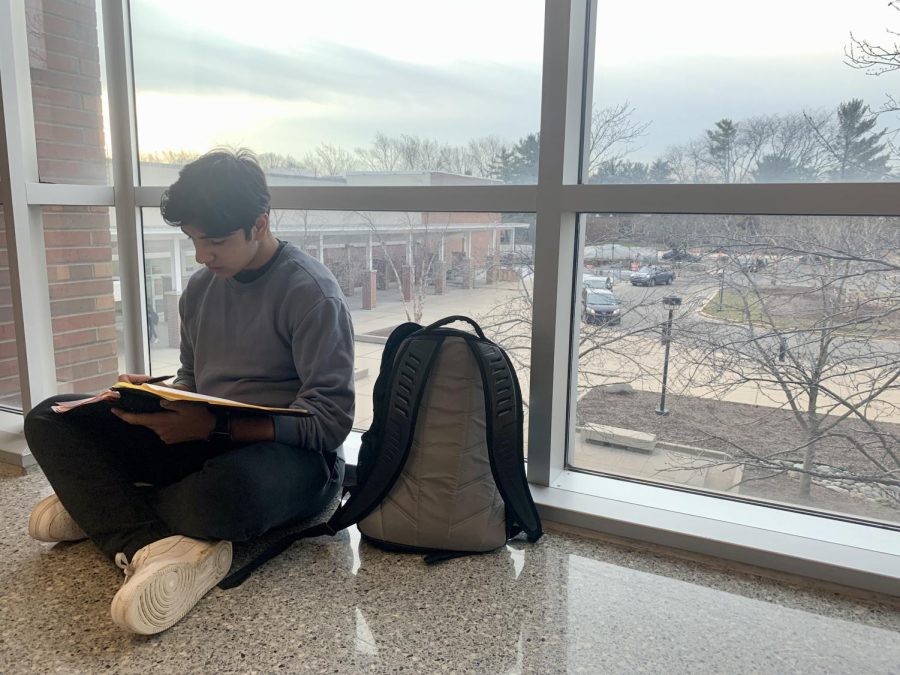Junior Sanay Bahl said he used to study in the dark, relying on just his desk lamp, but as a result his productivity suffered. So he tried something different—studying in the daylight—and he said he began to see benefits.
“Natural light has impacted my productivity by making me less distracted,” Bahl said. “I can focus for a longer time when my windows are open versus when I turn on a lamp. I can get a lot more work done because when my windows are open; I can focus better and I just feel like natural light allows me to have a better studying environment.”
Bahl is not alone. According to a recent survey conducted by Future Workplace, a site geared towards people in the human resource field, 78% of survey respondents said access to natural light and views improve their overall happiness and well-being.
Alan Hedge, professor emeritus of human centered design at Cornell University, said having the right amount of natural light will provide the best environment for high productivity.
“For (natural light to impact productivity), there (has to be a) visual task,” he said via email. Let’s take a ‘simple’ visual task of reading a page of text. If this is a reflective page, a paper page, with a white background and black text, then this can’t be read in the dark because what the eyes see is the difference in light level between the background and the black text, and reading should be faster and easier as the light level increases, but only up to a point because too much light will ‘wash out’ the text. If the paper is glossy then higher light levels can cause reflective glare making it hard to read. But if you are reading from, say, an iPad screen, then the higher light levels will make it more difficult to read and eventually ‘washout’ the screen. So you can perhaps say that for a reflective task (e.g. reading from paper) there is a ‘goldilocks’ relationship, too little or too much light will lower ‘productivity’ for a visual task while a ‘just right’ level will give you the best ‘productivity.”

Junior Lani Samms said she believes having more natural light increases her alertness and her overall mood as well.
“Having natural light makes me feel happier,” she said. “When I am in a classroom (with windows), when there is natural light coming in and when there are days with a lot of natural light, it makes me more focused on my school work and my mood is better because I am getting all my work done, while in the (interior) classrooms, I’m not getting any work done.”
Bahl and Samms agree that natural light has improved their productivity.
“I have been more energetic since working with natural light and it has helped me wake up faster in the morning,” Bahl said. “Additionally, having natural lighting in the form of daylight has made me much less stressed in general, which is a really important trait to have.”
Hedge said the human brain’s ability to simulate hormones is why natural light improves productivity.
“In extended periods of darkness, melatonin will make us sleepy and we can also become more depressed (winter blahs), whereas in summer the periods of intense natural light will promote serotonin, making us feel livelier and more energetic and usually happier because, in bright outdoor light, the temperature tends to be warmer.”

Physics teacher David James, who had a window in his classroom removed last semester, said he prefers classrooms with natural light.
He said, “I think natural light just kind of literally brightens the mood of everyone and puts them in a better and happier place, being able to see the outdoors and have that light come in and have the ability to turn off the fluorescence (lights) if you want and still be able to see. So I think what it does is it makes people just be in a better mood, and a better mood will just make you more productive, in my opinion.”
James also said the removal of one of his classroom windows is not as impactful as the removal of windows in other classrooms.
“Losing just the one window in the back corner of the room behind everybody where they all sit doesn’t really impact it too much,” he said. “So I haven’t seen (that much impact) especially keeping, you know, 75% of the windows, it hasn’t impacted any noticeable amounts. So we’ve lucked out that way.”
A study conducted by professors at the University of New Mexico found that having natural light in classrooms can increase standardized test scores by almost 20%.
Bahl said this school should increase the amount of natural light by adding more windows or other ways to gain natural light.
“CHS should try and add more skylights or windows in order to let more natural light into the building,” Bahl said. “That would also save money because there would be less need for artificial lights, and it would improve the moods of the students.”
James said there are multiple ways besides just adding windows for classrooms to get more natural light.

“I have seen (something) like skylights, but like tubes that come in for interior rooms. And it’d be like a tube of light or a tube up to the roof. So you get a little, you know, columns bringing light in, that would be an option,” he said. “I think the way the school is designed is just that most classrooms are out of luck. I would love to see those B hallway science rooms that are on the exterior of the building get windows. And so I think that would be a smart thing to do to get more natural light. Because you know, if you have an exterior wall, why don’t we have a window in it?”
Samms said teachers can also increase the number of natural light students receive by changing where students learn.
“When it is warmer, teachers could possibly take us outside to do work, especially (classes in the interior classrooms), because it will make it easier to focus and make me less distracted, so (we) aren’t sitting in a classroom all day without any natural light,” Samms said.
Hedge said going outside and increasing the number of windows can indeed benefit students.
“(I would) encourage students to go outdoors (during) breaks, assuming the weather is OK, (as well as designing) large windows in classrooms, cafeterias and atria, (while using) daylight simulating artificial light lamps,” Hedge said.
Bahl and Samms said more natural light would be beneficial, allowing for greater productivity and learning at school.
Samms said, “Increasing natural light would be a positive thing for CHS because then student grades would go up, and overall everyone would be more alert and happier to be (at school) because there is more natural light.”

































![AI in films like "The Brutalist" is convenient, but shouldn’t take priority [opinion]](https://hilite.org/wp-content/uploads/2025/02/catherine-cover-1200x471.jpg)








































![Review: “The Immortal Soul Salvage Yard:” A criminally underrated poetry collection [MUSE]](https://hilite.org/wp-content/uploads/2025/03/71cju6TvqmL._AC_UF10001000_QL80_.jpg)
![Review: "Dog Man" is Unapologetically Chaotic [MUSE]](https://hilite.org/wp-content/uploads/2025/03/dogman-1200x700.jpg)
![Review: "Ne Zha 2": The WeChat family reunion I didn’t know I needed [MUSE]](https://hilite.org/wp-content/uploads/2025/03/unnamed-4.png)
![Review in Print: Maripaz Villar brings a delightfully unique style to the world of WEBTOON [MUSE]](https://hilite.org/wp-content/uploads/2023/12/maripazcover-1200x960.jpg)
![Review: “The Sword of Kaigen” is a masterpiece [MUSE]](https://hilite.org/wp-content/uploads/2023/11/Screenshot-2023-11-26-201051.png)
![Review: Gateron Oil Kings, great linear switches, okay price [MUSE]](https://hilite.org/wp-content/uploads/2023/11/Screenshot-2023-11-26-200553.png)
![Review: “A Haunting in Venice” is a significant improvement from other Agatha Christie adaptations [MUSE]](https://hilite.org/wp-content/uploads/2023/11/e7ee2938a6d422669771bce6d8088521.jpg)
![Review: A Thanksgiving story from elementary school, still just as interesting [MUSE]](https://hilite.org/wp-content/uploads/2023/11/Screenshot-2023-11-26-195514-987x1200.png)
![Review: "When I Fly Towards You", cute, uplifting youth drama [MUSE]](https://hilite.org/wp-content/uploads/2023/09/When-I-Fly-Towards-You-Chinese-drama.png)
![Postcards from Muse: Hawaii Travel Diary [MUSE]](https://hilite.org/wp-content/uploads/2023/09/My-project-1-1200x1200.jpg)
![Review: "Ladybug & Cat Noir: The Movie," departure from original show [MUSE]](https://hilite.org/wp-content/uploads/2023/09/Ladybug__Cat_Noir_-_The_Movie_poster.jpg)
![Review in Print: "Hidden Love" is the cute, uplifting drama everyone needs [MUSE]](https://hilite.org/wp-content/uploads/2023/09/hiddenlovecover-e1693597208225-1030x1200.png)
![Review in Print: "Heartstopper" is the heartwarming queer romance we all need [MUSE]](https://hilite.org/wp-content/uploads/2023/08/museheartstoppercover-1200x654.png)




